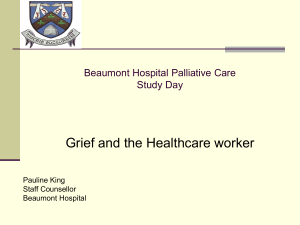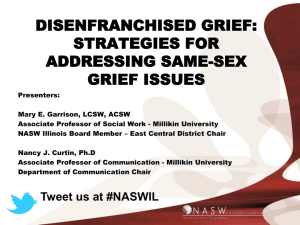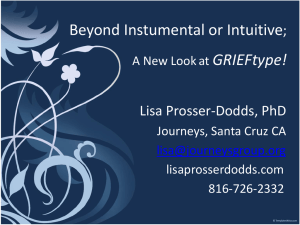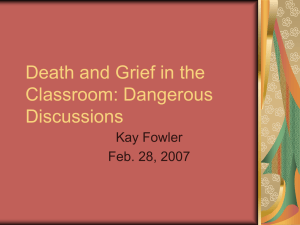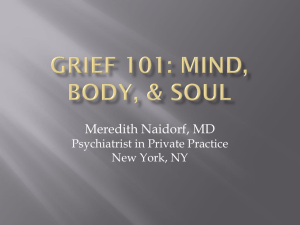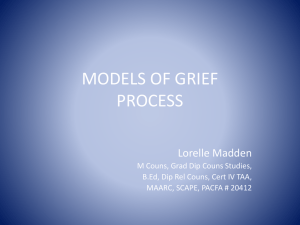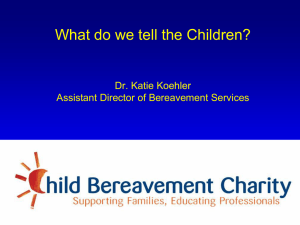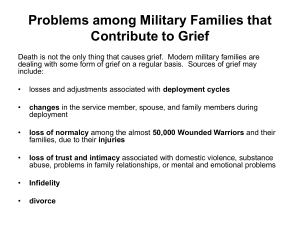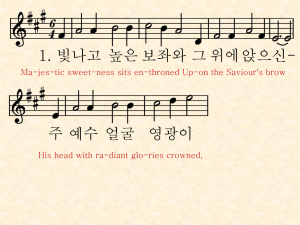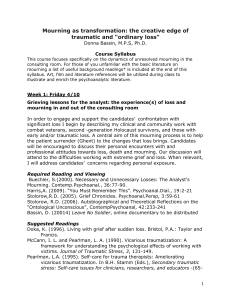Creating Meaning from Loss
advertisement
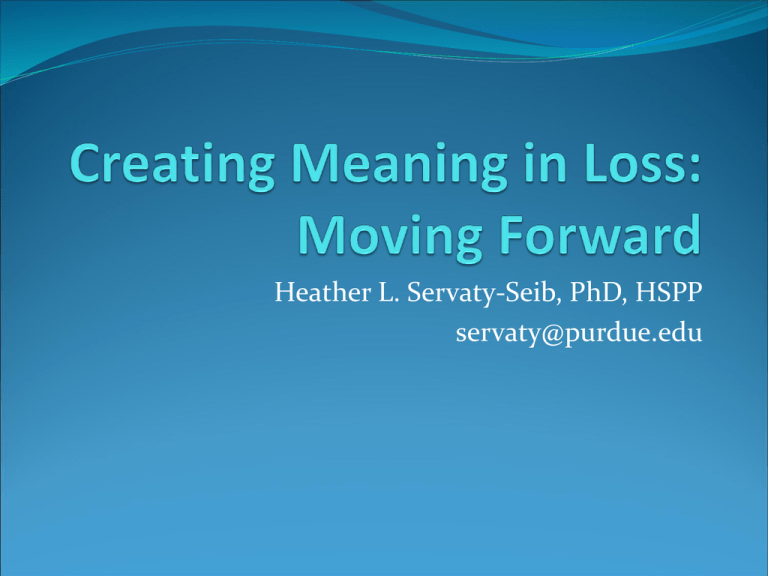
Heather L. Servaty-Seib, PhD, HSPP servaty@purdue.edu Types of Losses Physical Losses Psychosocial Losses (Rando, 1995) Secondary Losses Disenfranchised Grief (Doka, 1989; 2002) Unacknowledged—unrecognized Can be connected with the griever, the relationship, and/or the loss itself Definitions Bereavement Grief Multidimensional reactions—emotional, cognitive, physical, social, behavioral, spiritual Passive and involuntary Experienced as... Continuing development Natural and expectable Reaction to all types of losses Unique perception (Rando, 1995) Mourning Actions through which we incorporate death losses into our ongoing lives—engaged process rather than reaction. Will involve individual coping behaviors , social/cultural customs, etc. Active and voluntary Experienced as… Reorientation, integration, adaptation (Rando, 1995) Mourning as Meaning Making Human beings … construct their own reality, live in a narrative way, and make sense of the world in a narrative fashion. A death results in the loss of one of the main characters of our life novel and the story must be rewritten. According to Neimeyer (2000), “meaning reconstruction in response to loss is the central feature of grieving” (p. 47). Contexts of Meaning Making Sense-Making How does death fit into our understanding of the world? How do we need to change our understanding of the world now that it as occurred? Shattered assumptions (Janoff-Bulman, 1992) Relearning the world (Attig, 1996) Benefit-Finding or Lessons Learned We would not ever have wished the death—and yet what good if any can come from the death? Lessons might include greater self-awareness, valuing of relationships, enhanced appreciation for life and clarity regarding what is important in life (Neimeyer & Anderson, 2002) Contexts of Meaning Making Identity Reconstruction Who am I now that this death has occurred? Who will I become as I develop and age—knowing that this person will not physically be here? Reconstruction might include maturity, independence, existential growth, and resilience Competing identities (Heidt, 2005) (Neimeyer & Anderson, 2002) Ideas for Meaning Making Doing and resting (Heidt, 2005; Seah & Wilson, 2011) Compelling vs. not compelling Engagement vs. avoidance Multiple vs. singular approaches Self-review vs. self-judgment Realistic expectations vs. perfectionism Life purpose vs. life paralysis Relating vs. isolating Remembering vs. forgetting Two-Track Model Biopsychosocial functioning (Rubin, 1999) Visible emotional, cognitive, psychological and physical reactions Relationship to the deceased Manner in which relationship is continued and how that continuation/connection changes and shifts over time Wholeness of that relationship Examples of continuing bond approaches (Klass, Silverman, & Nickman, 1996) Talking, writing, and texting Integrating elements of his/her identity Engaging in connecting activities Important objects Recurring rituals Other Mourning Ideas… Writing—using any format that fits for you Intentional conversations with others who knew your loved one well Documenting dreams Recognizing symbols—openness to points of meaning Ideas from Lessons of Loss (Neimeyer, 2000) Biographies, painting and drawing, epitaphs, using metaphors, personal pilgrimage, photos, poetry, unsent letters Mourning is Relational Family context Importance of identification and respect for differences Elements of shared sense-making Broader definition of family—finding mentors in extended family or beyond Peer context Who do you share in depth with versus who do you just hang out with? Best to limit interactions with some (which is truly ok), but critical to find your supports. Connecting with other grieving students can be so powerful-what AMF is all about! References Attig, T. (1996). How we grieve: Relearning the world. New York: Oxford University Press. Doka, K. (Ed.). (1989).Disenfranchised grief: Recognizing hidden sorrow. Lexington, MA: Lexington. Doka, K. (Ed.). (2002). Disenfranchised grief: New directions, challenges, and strategies for practice. Champaign, IL: Research Press. Heidt, J. (2005). Processing loss, constructing identity: Young adults experiencing bereavement in the collegiate setting. Unpublished thesis, Willamette University, Salem, OR, USA. Janoff-Bulman, R. (1992). Shattered assumptions: Toward a new psychology of trauma. New York: Free press. Klass, D., Silverman, P. R., & Nickman, S. L. (Eds.). (1996). Continuing Bonds: A New Understanding of Grief. Washington, DC: Taylor & Francis. Neimeyer, R. A. (2000). Lessons of loss. Clayton, VIC: Centre for Grief Education, Inc. Neimeyer, R. A. (2001). Meaning reconstruction & the experience of loss. Washington, DC: American Psychological Association. Neimeyer, R. A., & Anderson, A. (2002). Meaning reconstruction theory. In N. Thompson (Ed.), Loss and grief: A guide for human services practitioners (pp. 45-64). New York: Palgrave. Rando, T. A. (1995). Grief and Mourning: Accommodating to Loss. In H. Wass and R. Neimeyer (Eds.), Dying: Facing the Facts. Washington, DC: Taylor and Francis. Rubin, S. (1999). The Two-Track Model of Bereavement: Overview, Retrospect and Prospect. Death Studies, 23, 681-714. Schultz, L. E. (2007). The influence of maternal loss on young women’s experience of identity development in emerging adulthood. Death Studies, 31, 17-43. Seah, C. H., & Wilson, A. (2011). A phenomenological study of university students’ grieving experiences. Illness, Crisis, and Loss, 19, 3-25.
